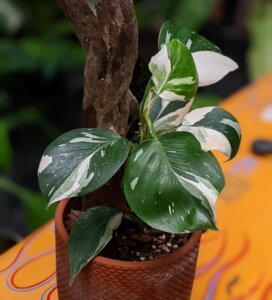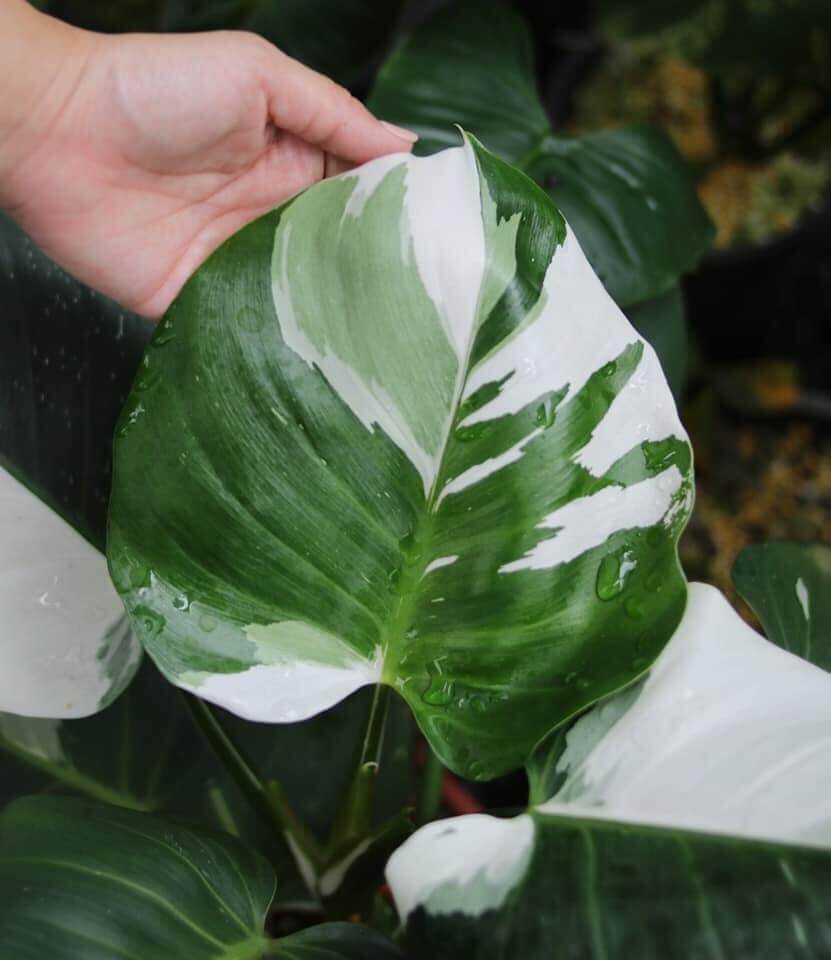Basic Information
The Philodendron White Wizard is a rare indoor plant with creamy white and green variegated leaves that grow on sleek green stems. It is a vining plant that can be encouraged to grow larger leaves with the help of a stake or trellis as it grows. Though hard to find, this plant is definitely worth the investment due to its stunning patterns and popularity among variegated plant enthusiasts.



Light
The Philodendron White Wizard is a hybrid plant that requires bright, indirect sunlight for 6-8 hours per day to grow healthy. Unlike other Philodendron varieties that can tolerate low-light conditions, this plant needs more light because its variegated leaves have less chlorophyll. However, direct sunlight can scorch its leaves, so keeping the plant away from it is essential. You should be mindful of the variegation because too little light can decrease it, and too much light can damage the leaves. East-facing windows are the best option as they provide morning sunlight, less intense than the afternoon sun. To maintain the plant’s health, add a sheer curtain to soften the sunlight or move it to a spot with less direct light.
Water
To maintain the health of your White Wizard Philodendron plant, water it appropriately, typically once a week or every 10 days. Check the top inch of the soil for dryness before watering. Thoroughly saturate the soil while watering, but ensure that excess water drains out to avoid overwatering. Overwatering can cause yellowing of leaves and soggy stems. If this happens, reduce watering frequency and allow the soil to dry out more before watering again. Keep an eye out for root rot and take action as necessary.
Soil
The White Wizard plant requires soil that drains well and is rich in organic matter. You can blend peat moss, perlite, and vermiculite to make a good potting mix. Garden soil is not recommended as it is typically too dense and lacks the necessary aeration and drainage for healthy growth. It is important to note that the soil’s pH level should be slightly acidic, around 5.5 to 6.5. Do not use compacted soil as it can hinder proper drainage and lead to root rot. Also, avoid overwatering to prevent waterlogged soil.
Tip: If you prefer using soilless mediums to grow White Wizard plants, use a 100% rice hull or labhang mix. Just make sure that the mix is decomposing and not fresh.
Temperature
An ideal temperature range of 65°F to 80°F (18°C to 27°C) should be maintained consistently for the plant’s proper growth. It is less tolerant of temperature fluctuations, so it should be kept away from drafty windows or doors and extreme temperatures. Both excessively hot and cold conditions can cause damage to the plant and affect its growth.
Humidity
The White Wizard plant thrives in environments with high humidity levels, ideally between 60% to 80%. If the humidity level is low, the plant may show signs of distress, such as brown leaf tips and wilting. You can maintain the required humidity level through various methods, such as using humidifiers, pebble trays, or misting. Rooms like the bathroom or laundry room that naturally have high humidity levels are perfect for this tropical plant. However, too much humidity can lead to mold or mildew on the leaves, so it’s essential to ensure proper ventilation by placing the plant near a window or in a well-ventilated area.
Fertilizer
Philodendron White Wizard requires regular fertilization during the growing season, which lasts from spring to fall. For best results, use a balanced fertilizer every two weeks, reducing to once a month during winter. When you observe foliage growth, you can fertilize with a ¼-strength diluted liquid fertilizer or top dress the soil with worm castings or rich compost. Alternatively, you can choose a fertilizer with more phosphorus and less nitrogen, such as a 15-30-15 NPK ratio fertilizer. To make the ideal solution, mix 1 teaspoon of fertilizer with 2 gallons of water. Before applying the fertilizer solution, it is advisable to water the plant with plain water to avoid shocking it. Over-fertilization can be harmful to the plant, causing nutrient burn. Therefore, ensure not to overdo it.
Tip: If you over-fertilize, remove visible salts from the soil and flush with water to dilute excess nutrients.
Growth Rate
Vining philodendrons have a medium-fast growth rate. Once established and provided with proper care, they can grow very long, up to ten times the length of your arm due to their vining nature.
Tip: White wizard Philodendrons are climbing vines and will produce more extensive, impressive foliage if given a moss pole or trellis to climb.
Pet Safety
This plant is toxic to pets due to calcium oxalate crystals. Ingestion can cause irritation, swelling, and more severe symptoms. It is advised to keep the plant out of reach of pets and wash hands after handling.
Grow in Semi-Hydro
- Philodendrons, celebrated for their lush foliage and adaptability, thrive in semi-hydroponic systems such as LECA/Pon, thanks to their resilient root systems and preference for consistent moisture.
- Shifting a Philodendron to a semi-hydroponic setting works well using a Nutrient Stagnant Wicking (NSW) method, providing a stable and effective environment for growth.
- Within the LECA/Pon environment, Philodendron roots adapt swiftly, effectively managing any early challenges in adapting to the NSW system.
- For nourishing Philodendrons in semi-hydro systems, a nutrient solution with a concentration around 800-1000ppm is optimal.
- Philodendrons are versatile in adapting to a range of temperature and humidity levels, making them ideal for various indoor settings.
- Regular care involves keeping an eye on the water level in the reservoir and periodically flushing the system to ensure the Philodendron’s healthy and consistent growth.
- If your Philodendron is a climber, it’s a must to look at our Moss Pole guide to have a proper set-up.
Tips
- Check for pests like spider mites and mealybugs regularly. Treat with insecticidal soap or neem oil if infested.
- Be mindful of common diseases such as root rot and leaf spot. Address them by ensuring proper watering practices and air circulation.
- Propagate through stem cuttings in well-draining soil or water, maintaining humidity and indirect light.
- When selecting a nursery, look for vibrant green leaves, slightly damp soil, firm, light-colored roots, and a full, bushy shape.
- Staking your plant to climb upwards encourages more significant leaf development.
- Wash their leaves monthly for better photosynthesis.
We have completed our Philodendron White Wizard care guide! This plant is a unique addition to any collection, with its enchanting variegation and mysterious history.
Happy planting! 🌱


